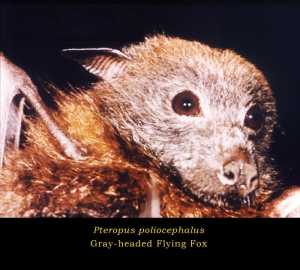
08 May Bat Borne Nipah Virus Transmitted by Human Secretions
MedicalResearch.com Interview with:
Birgit Nikolay PhD
MATHEMATICAL MODELLING OF INFECTIOUS DISEASES
Institut Pasteur
MedicalResearch.com: What is the background for this study? What are the main findings?
Response: Nipah virus was identified by the World Health Organization as an emerging infectious disease that may cause major epidemics if the pathogen evolves to become more transmissible, leading the organization to prioritize it for research to prevent future health emergencies. In the absence of efficient treatments or vaccines, the only way to control Nipah virus outbreaks is through targeted interventions that limit opportunities of spread. Designing such interventions is challenging in a context where transmission mechanisms remain poorly understood. The study provides important insights to better understand these mechanisms.

This image depicts the head of a gray-headed flying fox, Pteropus poliocephalus
CDC/ Brian W.J. Mahy,
MedicalResearch.com: Can you tell us a little about the Nipah virus? Where is it found? What kind of disease does it cause?
Response: Nipah virus is a bat-borne virus found throughout South and South East Asia. It causes severe neurological and respiratory disease in humans, with a case fatality >70%. Currently no treatment or vaccines are available.
MedicalResearch.com: What are the main findings?
Response: The study showed that, in particular, adult cases with respiratory symptoms transmitted the virus to more individuals than others, while contacts exposed to body fluids, including respiratory secretions, were more likely to get infected than others.
MedicalResearch.com: What should readers take away from your report?
Response: When the isolation of all suspected Nipah cases is not possible, adult cases with respiratory symptoms should be targeted for interventions. Moreover, protective measures should be implemented among contacts to avoid exposure to body fluids.
MedicalResearch.com: What recommendations do you have for future research as a result of this work?
Response: Future research should focus on investigating biological characteristics of Nipah patients in order to help better understand how the virus propagates in the human body and refine criteria to identify likely Nipah spreaders.
Citation:
Transmission of Nipah Virus — 14 Years of Investigations in Bangladesh
Birgit Nikolay, Dr.rer.nat., Henrik Salje, Ph.D., M. Jahangir Hossain, M.B., B.S., A.K.M. Dawlat Khan, M.S.S., Hossain M.S. Sazzad, M.B., B.S., Mahmudur Rahman, Ph.D., Peter Daszak, Ph.D., Ute Ströher, Ph.D., Juliet R.C. Pulliam, Ph.D., A. Marm Kilpatrick, Ph.D., Stuart T. Nichol, Ph.D., John D. Klena, Ph.D., et al.
May 9, 2019
N Engl J Med 2019; 380:1804-1814
DOI: 10.1056/NEJMoa1805376
[wysija_form id=”3″]
[last-modified]
The information on MedicalResearch.com is provided for educational purposes only, and is in no way intended to diagnose, cure, or treat any medical or other condition. Always seek the advice of your physician or other qualified health and ask your doctor any questions you may have regarding a medical condition. In addition to all other limitations and disclaimers in this agreement, service provider and its third party providers disclaim any liability or loss in connection with the content provided on this website.
Last Updated on May 8, 2019 by Marie Benz MD FAAD

